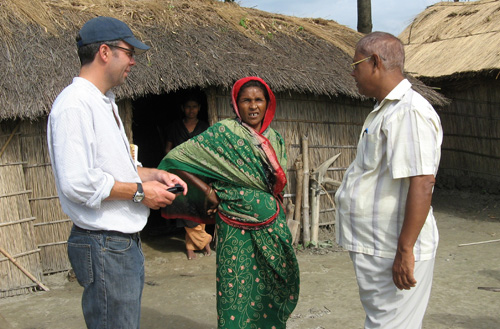
In Canada, when farmland is taken over for industrial or government purposes, we usually think of farmers selling their properties, and perhaps having enough money to buy a new farm elsewhere or to start a new way of life. It’s probably not that simple in reality, and it’s nowhere near that simple in other countries, such as India, where land rights and zoning are not as clearly defined.
Political science professor Craig Johnson has been funded by the Social Science and Humanities Research Council of Canada to study the effects of changing land use policies in countries like India and Bangladesh. “Many farmers have been working on a particular area of land for generations, but have no formal title to it,” he explains. “As well, because farming in India is so intensive, a whole class of labourers is displaced when farmlands are sold or taken over.”
That means the growing industrialization in some of these countries can have dramatic effects.
Johnson’s focus is on the two cities of Dhaka and Kolkata. While both cities are in the Ganges-Brahmaputra Basin – home to an estimated 400 million people – Kolkata is in India and Dhaka is in Bangladesh, two countries with somewhat different political systems. “My work uses a combination of archival research and interviews to explore how these political systems are able to protect – or not protect – their more vulnerable citizens,” says Johnson.
He’s been studying south Asian communities for more than 10 years, examining policies aimed at reducing poverty and vulnerability to environmental change. But in the last two decades, India and Bangladesh have been breaking down trade barriers and regulations, and becoming rapidly industrialized. This has meant many more people – most of them very poor – have been displaced and a whole host of new, more complex, environmental problems have been created, including issues of waste disposal, water treatment and air pollution. There is also increased vulnerability to the effects of climate change, such as flooding.
Despite the similarities between these two neighbouring countries, their political systems and policies are different. “India has social welfare and relatively ambitious safety nets for the poor,” Johnson explains. “The problem is that the policies are not always well-implemented. The closer you get to the local level, the more corrupted the system tends to be.”
His work suggests that in India, the three levels of government (municipal, state and federal) provide additional protection to the poor and vulnerable. The areas of jurisdiction overlap somewhat, and Johnson says, “You have a better chance of being heard if you have an external authority – the state or federal government – to turn to if you run up against problems with your local government.”
If your attempt to get help from the government has failed, you can always go to court. As has happened in the U.S. and Canada, the courts in India have become more interventionist and accepted more public interest cases, says Johnson. “The Supreme Court in India has established the right to life and to food, for example, and the court’s rulings often help those who are otherwise powerless.”
Bangladesh, on the other hand, is a unitary state without multiple levels of government. “People facing problems with the government can go to the courts, but there is no other external authority to turn to,” explains Johnson. The judicial system is also highly politicized.
Industry in Dhaka has developed very quickly. “Check the tags on your clothes,” suggests Johnson, “and you’ll probably find something made in Bangladesh.” The country has created special export zones which have led to increased employment and a new middle class in these areas, but the industries also require people to work long hours, often in unsafe working conditions, and have displaced many farmers and rural residents.
India is also experiencing rapid growth, but has a well-established structure to help more vulnerable people. “For example, the national employment program guarantees everyone 100 days of work per year,” says Johnson.
Understanding how various policies and political structures affect the outcomes for vulnerable populations may help with future planning, according to Johnson. Working with a team of U of G graduate students, his hope is that the research findings will help to identify the policies and best practices that may help reduce vulnerability to forced displacement and environmental change.